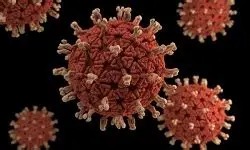Introduction

Coltiviruses are a group of viruses that belong to the Reoviridae family, known to cause a feverish illness in humans known as Colorado Tick Fever (CTF). Though not as widespread as the flu, CTF and related infections are important due to their geographic association, vector (tick) involvement, and potential for misdiagnosis.
Viruses are microscopic agents that can cause a wide range of illnesses in humans, animals, and plants. Some are well-known, like influenza or HIV, while others are more obscure yet equally important. One such lesser-known but medically significant virus is the Coltivirus.
In this overview, we’ll explore everything about Coltivirus—from its structure and transmission to symptoms, diagnosis, and prevention—explained in a simple, humanized way.
Table of Contents
Definition: What is Coltivirus?

Coltivirus refers to a genus of viruses within the family Reoviridae, subfamily Sedoreovirinae. These viruses have double-stranded RNA genomes and are primarily known for causing Colorado Tick Fever (CTF) in humans.
Key Characteristics:
- Family: Reoviridae
- Genus: Coltivirus
- Genome: Segmented double-stranded RNA
- Vector: Ticks (especially the Rocky Mountain wood tick)
- Host: Humans, small mammals, and ticks
- Disease caused: Colorado Tick Fever
History and Discovery
- The Colorado Tick Fever virus (CTFV), the most well-known coltivirus, was first identified in Colorado, USA, in the 1940s.
- The disease was recognized in people who had been bitten by ticks in the Rocky Mountains and developed fever, chills, and muscle pain.
- The virus was later isolated from both humans and ticks, and research began to uncover its structure and mode of action.
Types of Coltiviruses
There are multiple coltiviruses, but the two most recognized include:
- Colorado Tick Fever Virus (CTFV) – Found in North America, causes CTF in humans.
- Eyach Virus – Found in parts of Europe, causes CTF-like illness, and is transmitted by ticks.
Structure of Coltivirus
Like all viruses, coltiviruses are made up of genetic material enclosed in a protein coat. Here’s what makes them special:
Key Features:
- Double-stranded RNA (dsRNA) genome, made up of 12 segments
- Non-enveloped (they lack a lipid membrane)
- Icosahedral shape (spherical with 20 faces)
- Around 60–80 nanometers in diameter
Because they are non-enveloped, coltiviruses are more stable in the environment and resistant to drying and disinfectants compared to enveloped viruses.
Transmission: How Do People Get Infected?
Vector: The Rocky Mountain wood tick (Dermacentor andersoni)
- Ticks become infected by feeding on small rodents (chipmunks, squirrels, etc.) that harbor the virus.
- Infected ticks carry the virus in their salivary glands and pass it to humans during a tick bite.
Humans:
- Humans are accidental hosts and do not spread the virus to others.
- Person-to-person transmission does not occur (except possibly through blood transfusion or rare organ transplant cases).
Where is Coltivirus Found? (Geographic Distribution)
Coltiviruses are geographically limited to specific areas where the vector tick is present.
Colorado Tick Fever Virus (CTFV):
- Found mainly in the western United States and Canada, especially in:
- Colorado
- Utah
- Idaho
- Montana
- Wyoming
- California
- Oregon
- Most infections occur during spring and early summer, when ticks are most active.
Eyach Virus:
- Found in Europe (Germany, France, Switzerland)
- Also spread by Ixodes ticks
Colorado Tick Fever (CTF): The Disease
CTF is the main illness caused by Coltivirus in humans. It typically follows a biphasic pattern—meaning the symptoms may go away and then return.

Incubation Period:
Usually 3 to 6 days after the tick bite.
Symptoms of CTF:
| Phase | Symptoms |
|---|---|
| Initial (3–4 days) | Sudden fever, chills, headache, muscle pain, fatigue, nausea |
| Remission (1–2 days) | Fever and symptoms temporarily improve |
| Relapse (2–3 more days) | Fever returns with possible rash, eye pain, sore throat |
Other symptoms:
- Joint pain
- Light sensitivity (photophobia)
- Vomiting
- Skin rash (less common)
In Severe Cases:
- May lead to meningitis (infection of brain/spinal cord membranes)
- Encephalitis (brain swelling)
- Rare cases of hemorrhage or shock
- More serious in children under 5 or those with weak immune systems
How is CTF Diagnosed?
Since CTF symptoms can mimic other illnesses (like the flu, Lyme disease, or West Nile virus), lab testing is essential for confirmation.
Diagnostic Tests:
- RT-PCR (Reverse Transcriptase PCR)
- Detects viral RNA in the blood.
- Useful during the early stages (within first 14 days).
- Serological Tests (IgM/IgG antibodies)
- Detect antibodies made by the immune system.
- May take 7–10 days after infection to appear.
- Virus Isolation
- Rarely done due to safety concerns; involves growing the virus from blood.
- Complete Blood Count (CBC)
- May show leukopenia (low white blood cell count) or thrombocytopenia (low platelets).
Treatment of CTF
There is no specific antiviral treatment for CTF. Treatment is supportive, which means it focuses on relieving symptoms.
Supportive Care Includes:
- Plenty of fluids
- Pain relievers and fever reducers (e.g., acetaminophen)
- Rest
- Hospital care for severe cases
Avoid aspirin in children, as it may cause Reye’s syndrome.
Recovery and Prognosis
- Most people recover within 7–10 days.
- Fatigue may last for weeks or months in some.
- Complications (meningitis or encephalitis) are rare but possible.
- Once infected, a person usually gains long-term immunity.
Prevention of Coltivirus Infections
Since there is no vaccine, prevention focuses on avoiding tick bites.
Tick Bite Prevention Tips:
- Wear long sleeves and pants when in tick-infested areas
- Use insect repellents (with DEET or permethrin)
- Stay on cleared trails, avoid tall grasses and brush
- Check for ticks on skin and clothing after outdoor activities
- Remove ticks promptly with tweezers
- Shower and wash clothes after coming indoors
Blood Donation Precaution:
- People who have had CTF should not donate blood for at least 6 months after recovery to avoid rare cases of transfusion-related transmission.
Coltivirus vs. Other Tick-Borne Diseases
| Disease | Virus Type | Symptoms | Key Differences |
|---|---|---|---|
| CTF (Coltivirus) | dsRNA | Biphasic fever, headache, joint pain | No rash (usually), not contagious |
| Lyme Disease | Bacteria | Bullseye rash, joint pain | Caused by Borrelia |
| Rocky Mountain Spotted Fever | Bacteria | Fever, rash, bleeding | More severe, needs antibiotics |
| Powassan Virus | Flavivirus | Neurological symptoms | More severe, rare but fatal |
Fun and Interesting Facts
- The term “biphasic fever” (fever that comes and goes) is a hallmark of CTF.
- Children and outdoor workers are most at risk.
- CTF is sometimes misdiagnosed as influenza or mononucleosis due to overlapping symptoms.
- Blood samples must be handled carefully because the virus can survive in blood products for weeks.
Summary Table
| Feature | Details |
|---|---|
| Virus Type | Coltivirus (dsRNA, segmented) |
| Main Disease | Colorado Tick Fever |
| Vector | Rocky Mountain wood tick |
| Reservoirs | Rodents (chipmunks, squirrels) |
| Human Transmission | Tick bite (no person-to-person spread) |
| Diagnosis | PCR, antibody tests |
| Treatment | Supportive care only |
| Prevention | Tick bite avoidance |
| Vaccine | None |
Conclusion
Coltivirus, though lesser-known, plays a significant role in tick-borne human diseases—especially in North America. The Colorado Tick Fever virus (CTFV), its most prominent member, can cause a biphasic fever with muscle pain, chills, and fatigue, and may lead to more severe complications in vulnerable groups.
Though not typically life-threatening, proper awareness, diagnosis, and prevention are essential—especially for those living in or visiting tick-prone mountain regions.
With no vaccine or specific treatment available, avoiding tick bites remains the best defense. Education, early detection, and supportive care can make a major difference in reducing the impact of this rare but important virus.
FREQUENTLY ASKED QUESTIONS
What is Coltivirus?
Coltivirus is a genus of viruses belonging to the Reoviridae family. The most well-known member is the Colorado Tick Fever Virus (CTFV), which causes a tick-borne viral illness in humans called Colorado Tick Fever (CTF).
What disease does Coltivirus cause in humans?
Coltivirus causes Colorado Tick Fever (CTF)—a viral illness characterized by biphasic fever, headache, muscle pain, and fatigue. Another related virus, the Eyach virus, causes similar symptoms in Europe.
How is Coltivirus transmitted?
CTFV is transmitted through the bite of infected ticks, mainly the Rocky Mountain wood tick (Dermacentor andersoni). There is no person-to-person transmission.
Related Articles




